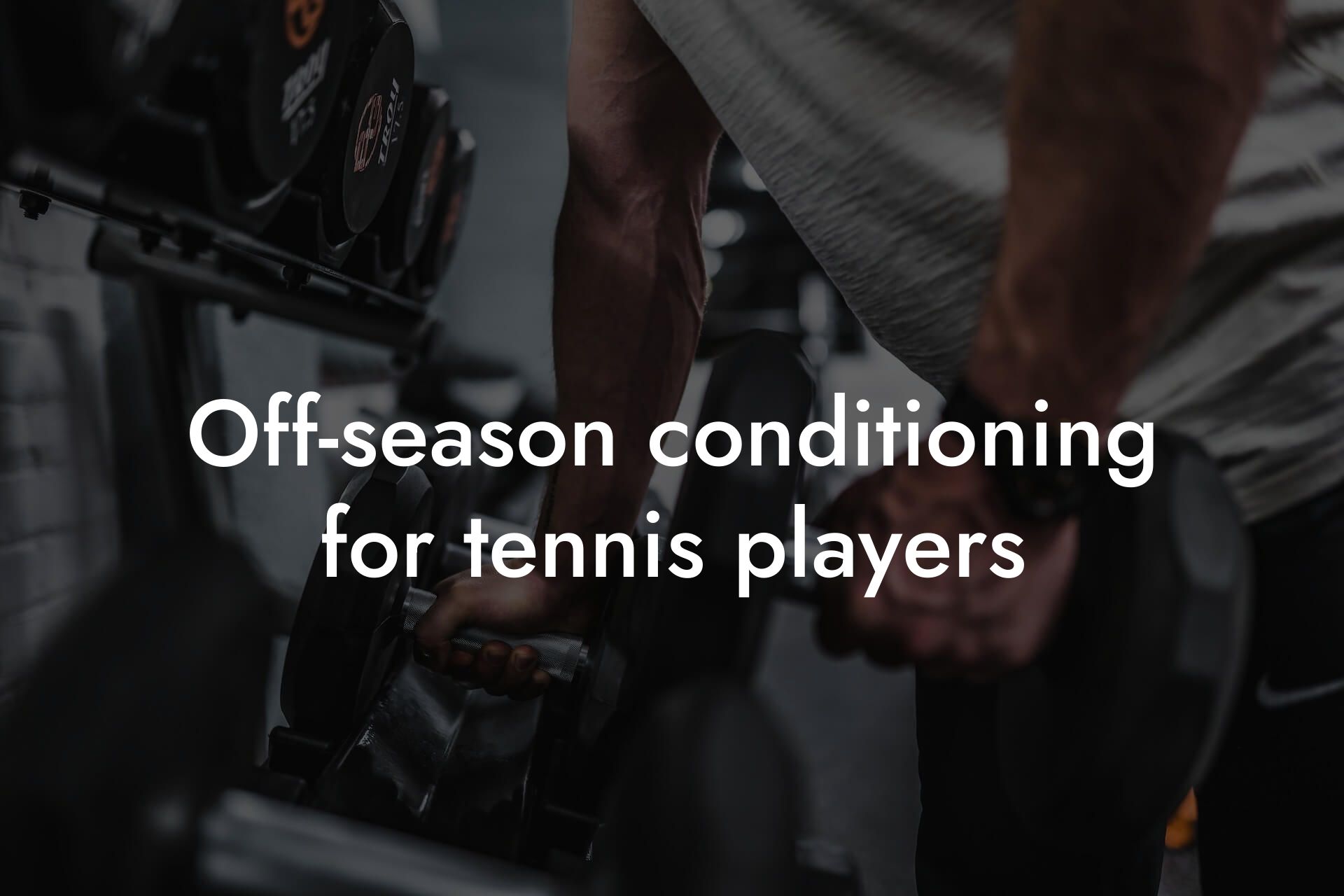As a tennis professional, you understand the importance of maintaining peak physical condition to stay competitive in the sport. The intense physical demands of tennis can take a toll on your body, making recovery techniques essential for optimal performance and injury prevention. At Tano Performance Group, we recognize the significance of recovery in achieving success on the court. In this article, we'll delve into the most effective recovery techniques for tennis professionals, highlighting their benefits and implementation strategies.
Table of Contents
- The Importance of Recovery in Tennis
- Types of Recovery Techniques for Tennis Professionals
- Active Recovery Techniques for Tennis Professionals
- Passive Recovery Techniques for Tennis Professionals
- Stretching and Foam Rolling for Tennis Professionals
- Cryotherapy and Heat Therapy for Tennis Professionals
- Sleep and Nutrition for Tennis Professionals
- Implementing Recovery Techniques into Your Training Regimen
- Frequently Asked Questions
The Importance of Recovery in Tennis
Tennis is a high-intensity sport that requires rapid movements, explosive power, and sustained endurance. The repetitive nature of tennis strokes, combined with the high-impact landing from jumps and quick changes of direction, can lead to fatigue, inflammation, and injury. Adequate recovery is crucial to repair and adapt to the physical demands of tennis, allowing you to maintain performance levels and reduce the risk of injury.
Types of Recovery Techniques for Tennis Professionals
There are various recovery techniques that tennis professionals can incorporate into their training regimen. These include:
1. Active Recovery: Engaging in low-intensity aerobic activities such as cycling, swimming, or jogging to promote blood flow and remove waste products without exacerbating fatigue.
2. Passive Recovery: Using techniques like foam rolling, massage, or compression garments to reduce muscle soreness and improve circulation.
3. Stretching and Foam Rolling: Targeting specific muscle groups to improve flexibility, reduce muscle tension, and enhance range of motion.
4. Cryotherapy and Heat Therapy: Applying cold or heat to affected areas to reduce inflammation, relax muscles, and promote healing.
5. Sleep and Nutrition: Prioritizing adequate sleep and a balanced diet to support muscle repair, recovery, and adaptation.
Active Recovery Techniques for Tennis Professionals
Active recovery techniques are designed to promote blood flow, remove waste products, and maintain cardiovascular fitness without exacerbating fatigue. Examples of active recovery techniques for tennis professionals include:
Cycling: A low-impact, low-intensity cycling session can help promote blood flow and flush out waste products without putting excessive stress on the joints.
Swimming: Swimming is a low-impact, aerobic exercise that can help improve cardiovascular fitness while reducing the risk of impact-related injuries.
Jogging or Running: A low-intensity jogging or running session can help maintain cardiovascular fitness while promoting blood flow and removal of waste products.
Passive Recovery Techniques for Tennis Professionals
Passive recovery techniques are designed to reduce muscle soreness, improve circulation, and promote relaxation. Examples of passive recovery techniques for tennis professionals include:
Foam Rolling: Using a foam roller to target specific muscle groups, such as the IT band, quadriceps, and hamstrings, can help reduce muscle tension and improve circulation.
Massage: Receiving a massage can help reduce muscle soreness, improve circulation, and promote relaxation.
Compression Garments: Wearing compression clothing, such as tights or sleeves, can help improve circulation, reduce muscle soreness, and promote recovery.
Stretching and Foam Rolling for Tennis Professionals
Stretching and foam rolling are essential components of a tennis professional's recovery routine. These techniques can help improve flexibility, reduce muscle tension, and enhance range of motion. Key areas to target include:
The IT Band: A common area of tension in tennis players, the IT band can be targeted using foam rolling or stretching exercises.
The Quadriceps and Hamstrings: Stretching and foam rolling these muscle groups can help reduce muscle tension and improve flexibility.
The Shoulders and Chest: Targeting these areas can help improve flexibility and reduce muscle tension in the upper body.
Cryotherapy and Heat Therapy for Tennis Professionals
Cryotherapy and heat therapy are effective recovery techniques for tennis professionals. These modalities can help reduce inflammation, relax muscles, and promote healing. Examples include:
Ice Baths: Immersing yourself in an ice bath can help reduce inflammation, relax muscles, and promote recovery.
Cold Compression: Applying cold compression to affected areas can help reduce inflammation and promote recovery.
Heat Therapy: Applying heat to affected areas can help relax muscles, reduce muscle spasms, and promote healing.
Sleep and Nutrition for Tennis Professionals
Sleep and nutrition play critical roles in the recovery process for tennis professionals. Adequate sleep is essential for muscle repair, recovery, and adaptation, while a balanced diet provides the necessary building blocks for muscle growth and repair.
Aim for 7-9 hours of sleep each night to support muscle recovery and adaptation.
Focus on consuming a balanced diet that includes lean protein sources, complex carbohydrates, and healthy fats.
Implementing Recovery Techniques into Your Training Regimen
To maximize the benefits of recovery techniques, it's essential to incorporate them into your training regimen in a structured and consistent manner. Consider the following strategies:
Schedule recovery sessions into your training calendar, just as you would schedule practice sessions or matches.
Make recovery a priority, allocating time and resources to support your recovery goals.
Monitor your body's response to different recovery techniques, adjusting your approach as needed.
Work with a coach, trainer, or sports scientist to develop a personalized recovery plan tailored to your specific needs and goals.
In conclusion, recovery techniques are essential for tennis professionals seeking to optimize performance, reduce injury risk, and maintain a competitive edge. By incorporating active recovery, passive recovery, stretching, foam rolling, cryotherapy, heat therapy, sleep, and nutrition into your training regimen, you can take your game to the next level. Remember to prioritize recovery, make it a consistent part of your training routine, and monitor your body's response to different techniques. With the right approach, you can unlock your full potential and achieve success on the court.
At Tano Performance Group, we're committed to helping high-earning professionals like you achieve their physical goals. Our state-of-the-art DEXA machine provides a comprehensive body assessment, giving you the insights you need to optimize your training and recovery. Contact us today to learn more about how our services can support your tennis career.
Frequently Asked Questions
What is the importance of recovery techniques for tennis professionals?
Recovery techniques are crucial for tennis professionals as they help to repair and rebuild muscles, tendons, and ligaments that are subjected to intense physical stress during competition. Proper recovery enables players to maintain optimal performance, reduce the risk of injury, and extend their careers.
What are the common injuries that tennis players are prone to?
Tennis players are susceptible to a range of injuries, including tennis elbow, shoulder impingement, rotator cuff strains, knee tendinitis, and ankle sprains. These injuries can be caused by repetitive strain, overuse, or sudden trauma.
How can tennis players incorporate recovery techniques into their training routine?
Tennis players can incorporate recovery techniques into their training routine by allocating time for recovery exercises, such as stretching, foam rolling, and self-myofascial release, after each training session or match. They can also prioritize rest days, active recovery, and cross-training to allow their bodies to recover.
What is the role of nutrition in recovery for tennis players?
Nutrition plays a critical role in recovery for tennis players. A balanced diet that includes protein, complex carbohydrates, and healthy fats helps to repair and rebuild muscles, replenish energy stores, and support immune function. Additionally, proper hydration is essential to help flush out toxins and reduce muscle soreness.
How can tennis players optimize their sleep for recovery?
Tennis players can optimize their sleep for recovery by establishing a consistent sleep schedule, creating a sleep-conducive environment, avoiding caffeine and electronics before bedtime, and getting 7-9 hours of sleep each night. Adequate sleep helps to repair and rebuild muscles, consolidate memories, and support immune function.
What is the importance of mental recovery for tennis players?
Mental recovery is crucial for tennis players as it helps to reduce stress, anxiety, and burnout. Mental recovery techniques, such as meditation, visualization, and positive self-talk, can help players to stay focused, motivated, and resilient, even in the face of adversity.
How can tennis players use compression garments to aid in recovery?
Compression garments, such as tights and sleeves, can help to improve blood flow, reduce muscle soreness, and enhance recovery. They work by applying gentle pressure to the affected area, which helps to promote lymphatic drainage and reduce inflammation.
What is the role of cryotherapy in recovery for tennis players?
Cryotherapy, such as ice baths and cryosaunas, can help to reduce inflammation, muscle soreness, and improve recovery. The cold temperatures help to constrict blood vessels, reduce metabolic rate, and promote relaxation, which can aid in the removal of waste products and reduce muscle damage.
How can tennis players use massage therapy to aid in recovery?
Massage therapy can help to improve circulation, reduce muscle tension, and enhance recovery. Massage can help to break down adhesions, promote lymphatic drainage, and reduce inflammation, which can aid in the removal of waste products and reduce muscle soreness.
What is the importance of stretching and foam rolling for tennis players?
Stretching and foam rolling are essential for tennis players as they help to improve flexibility, reduce muscle tension, and enhance recovery. These techniques can help to increase range of motion, reduce muscle imbalances, and promote relaxation, which can aid in the removal of waste products and reduce muscle soreness.
How can tennis players incorporate active recovery into their training routine?
Tennis players can incorporate active recovery into their training routine by engaging in low-intensity activities, such as cycling, swimming, or yoga, on their rest days. Active recovery helps to promote blood flow, reduce muscle soreness, and enhance recovery without exacerbating fatigue.
What is the role of supplements in recovery for tennis players?
Supplements, such as protein powder, creatine, and omega-3 fatty acids, can help to support recovery for tennis players. These supplements can help to promote muscle growth, reduce muscle soreness, and support immune function, which can aid in the removal of waste products and reduce muscle damage.
How can tennis players use technology to aid in recovery?
Tennis players can use technology, such as wearable devices and recovery apps, to aid in recovery. These tools can help to track sleep, monitor fatigue, and provide personalized recovery recommendations, which can aid in the removal of waste products and reduce muscle soreness.
What is the importance of periodization in recovery for tennis players?
Periodization is crucial for tennis players as it helps to alternate periods of intense training with periods of rest and recovery. This approach can help to reduce the risk of overtraining, prevent burnout, and promote long-term progress.
How can tennis players use breathing exercises to aid in recovery?
Breathing exercises, such as diaphragmatic breathing and box breathing, can help to reduce stress, anxiety, and muscle tension, which can aid in recovery. These exercises can help to promote relaxation, reduce inflammation, and enhance recovery.
What is the role of nutrition timing in recovery for tennis players?
Nutrition timing is critical for tennis players as it helps to optimize recovery. Consuming a balanced meal or snack within 30-60 minutes after exercise can help to replenish energy stores, repair and rebuild muscles, and support immune function.
How can tennis players use self-myofascial release to aid in recovery?
Self-myofascial release, using tools such as lacrosse balls and rollers, can help to reduce muscle tension, improve circulation, and enhance recovery. This technique can help to break down adhesions, promote lymphatic drainage, and reduce inflammation, which can aid in the removal of waste products and reduce muscle soreness.
What is the importance of recovery for tennis players during competition?
Recovery is crucial for tennis players during competition as it helps to maintain optimal performance, reduce the risk of injury, and enhance resilience. Proper recovery techniques, such as stretching, foam rolling, and self-myofascial release, can help to reduce muscle soreness, improve circulation, and promote relaxation, which can aid in the removal of waste products and reduce muscle damage.
How can tennis players use visualization techniques to aid in recovery?
Visualization techniques, such as mental rehearsal and guided imagery, can help to reduce stress, anxiety, and muscle tension, which can aid in recovery. These techniques can help to promote relaxation, reduce inflammation, and enhance recovery by reducing the body's stress response.
What is the role of hydration in recovery for tennis players?
Hydration is essential for tennis players as it helps to replenish fluids, electrolytes, and energy stores. Proper hydration can help to reduce muscle soreness, improve circulation, and enhance recovery by promoting the removal of waste products and reducing muscle damage.
How can tennis players incorporate strength training into their recovery routine?
Tennis players can incorporate strength training into their recovery routine by focusing on exercises that improve strength, power, and endurance. This can help to improve muscle imbalances, reduce the risk of injury, and enhance recovery by promoting the growth and repair of muscle tissue.
What is the importance of recovery for tennis players during the off-season?
Recovery is crucial for tennis players during the off-season as it helps to repair and rebuild muscles, tendons, and ligaments, and recharge energy stores. Proper recovery techniques, such as stretching, foam rolling, and self-myofascial release, can help to reduce muscle soreness, improve circulation, and promote relaxation, which can aid in the removal of waste products and reduce muscle damage.
How can tennis players use yoga to aid in recovery?
Yoga can help to improve flexibility, reduce muscle tension, and enhance recovery. Yoga can help to increase range of motion, reduce muscle imbalances, and promote relaxation, which can aid in the removal of waste products and reduce muscle soreness.
What is the role of compression socks in recovery for tennis players?
Compression socks can help to improve circulation, reduce muscle soreness, and enhance recovery. They work by applying gentle pressure to the affected area, which helps to promote lymphatic drainage and reduce inflammation.
Here are some related articles you might love...
- Strength training programs for tennis athletes
- The importance of DEXA scans for tennis players
- Off-season conditioning for tennis players
- How to maintain endurance during long tennis matches
- The role of bone density in preventing tennis injuries
- Improving core strength for better tennis strokes
- How body composition impacts tennis agility and speed
- Nutrition strategies for sustained energy during tennis matches
- Reducing body fat to enhance tennis performance
Zak Faulkner
Zak Faulkner is a leading authority in the realm of physical health and body composition analysis, with over 15 years of experience helping professionals optimise their fitness and well-being. As one the experts behind Tano Performance Group, Zak has dedicated his career to providing in-depth, science-backed insights that empower clients to elevate their physical performance and overall health.
With extensive knowledge of DEXA technology, Zak specializes in delivering comprehensive body assessments that offer precise data on body fat, muscle mass, bone density, and overall physique. His expertise enables individuals to make informed decisions and achieve their fitness goals with accuracy and confidence. Zak’s approach is rooted in a deep understanding of human physiology, combined with a passion for helping clients unlock their full potential through personalised strategies.
Over the years, Zak has earned a reputation for his commitment to excellence, precision, and client-focused service. His guidance is trusted by top professionals who demand the best when it comes to their health. Whether advising on fitness programs, nutritional strategies, or long-term wellness plans, Zak Faulkner’s insights are a valuable resource for anyone serious about taking their health and fitness to the next level.
At Tano Performance Group, Zak continues to lead our Content Team revolutionising how professionals approach their physical health, offering unparalleled expertise that drives real results.




